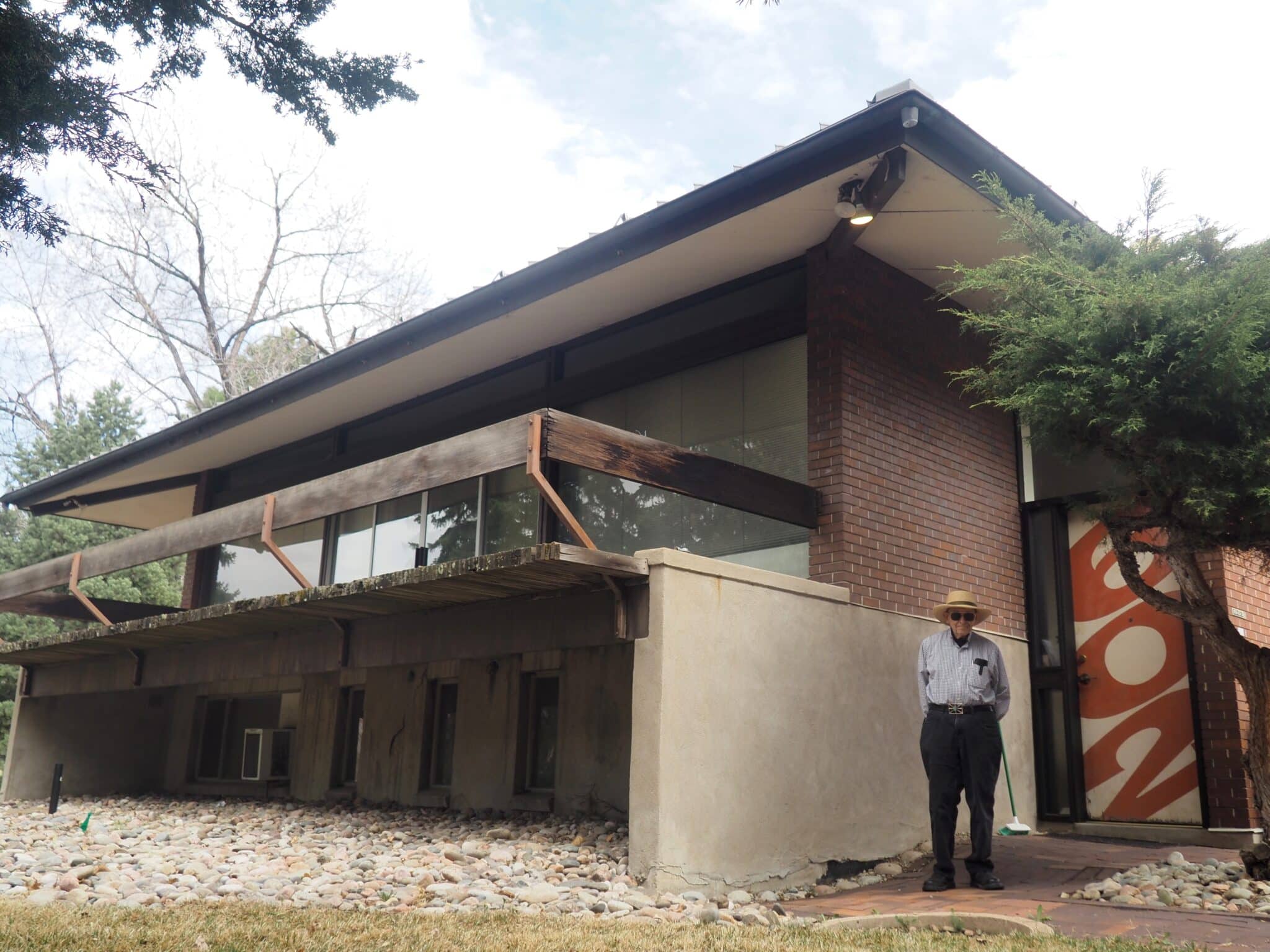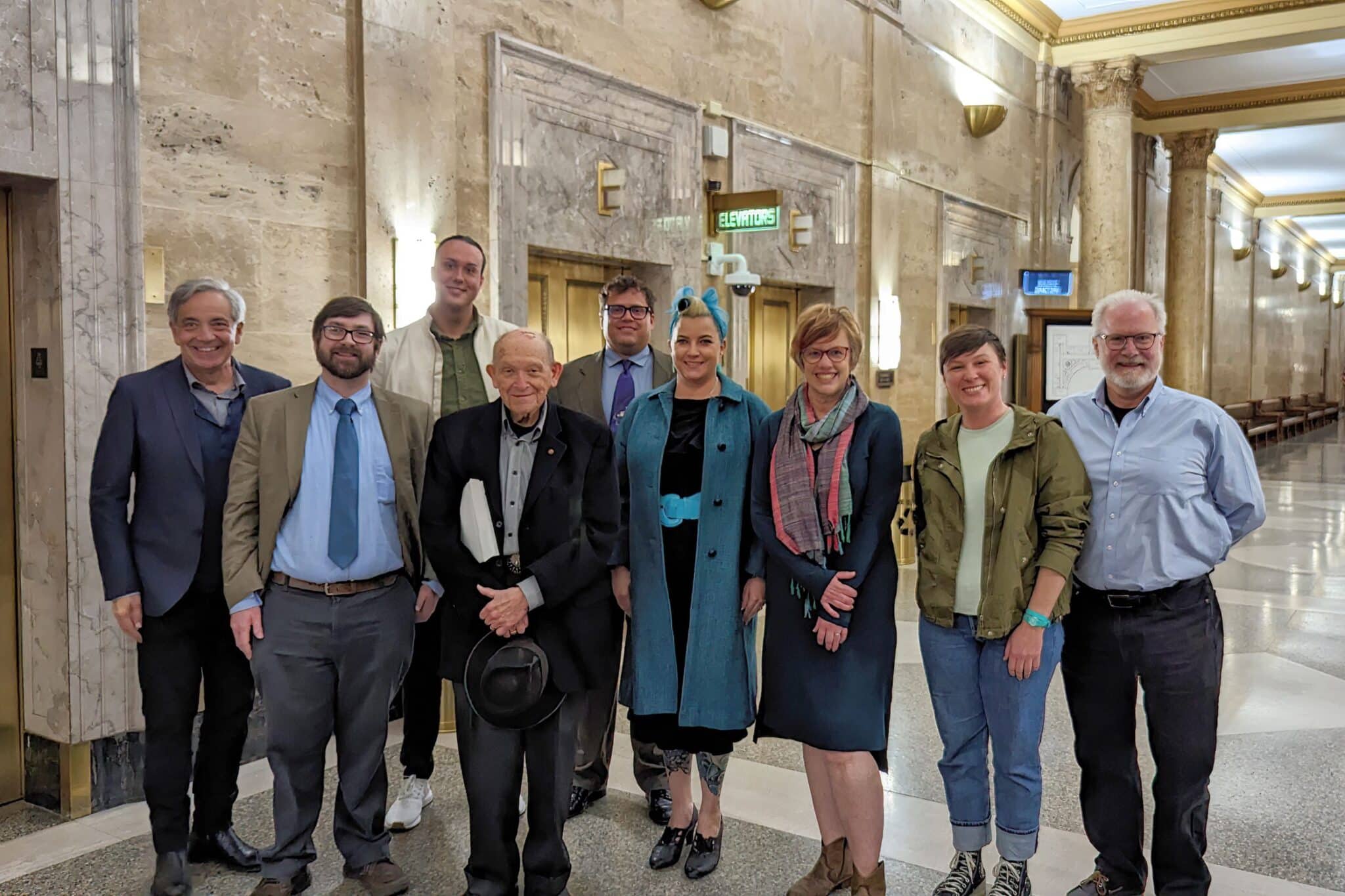
Alan Gass stands by his home in Denver’s Belcaro neighborhood in April. (Maia Luem/BusinessDen)
The day after the landmark designation application for architect Alan Golin Gass’s home was unanimously approved by the Denver City Council, he told BusinessDen he’s just relieved the process is finally over.
“It was torture, waiting through that gigantic agenda,” Gass said of the council meeting.
The Denver branch of Docomomo, an international organization dedicated to building conservation, first asked Gass to landmark his home at 602 S. Harrison Lane in the Balcaro neighborhood over three years ago.
“At this point I just need a lot of sleep. At my age, anything is exhausting,” the 92-year-old Gass said. “I’m just glad it’s over.”
The Harvard graduate told BusinessDen he designed the home in 1961 to start a family with his late wife, Sally, and has lived in it since.
“That was the whole reason for it’s being,” Gass said of his family.

Supporters of the landmark designation application, from left to right: Michael Hughes, Michael Flowers, Michael Harris, Alan Golin Gass, Atom Stevens, Kimber Dempsey, Abigail Christman, Brie Samyn and Tom Hart. (Courtesy Alan Gass)
The home is most notable for its glass doors that open to a deck spanning half the building, and its dome skylight. Landmark status effectively prevents demolition and requires any exterior changes be approved by a city board.
Gass, a fourth-generation Denverite, started his architecture career with I.M. Pei. He has worked for 12 architecture firms and founded his own firm, Alan Golin Gass Architecture, now known as AGGA, in 1960. Over his 50-year career, Gass worked on numerous Denver projects, but he said the majority have either been demolished or severely altered.
“I’m delighted because it assures me that this is at least one of my buildings that won’t be demolished,” Gass said.
Council members had no objection to the designation and it passed without much discussion. Councilman Chris Hinds thanked Gass for deciding to return home to Denver after graduating from Harvard.
“Mr. Gass, thank you so much for your contribution to our city for decades,” Hinds said.
Gass said he feared the designation wouldn’t pass after watching other applications get denied, like the one for the late architect Richard Crowther’s home in Cherry Creek. But that also motivated him.
“I figured this at least would be one house that might be preserved,” Gass said. “I guess you could say it’s a significant win for the modern movement.”

Alan Gass stands by his home in Denver’s Belcaro neighborhood in April. (Maia Luem/BusinessDen)
The day after the landmark designation application for architect Alan Golin Gass’s home was unanimously approved by the Denver City Council, he told BusinessDen he’s just relieved the process is finally over.
“It was torture, waiting through that gigantic agenda,” Gass said of the council meeting.
The Denver branch of Docomomo, an international organization dedicated to building conservation, first asked Gass to landmark his home at 602 S. Harrison Lane in the Balcaro neighborhood over three years ago.
“At this point I just need a lot of sleep. At my age, anything is exhausting,” the 92-year-old Gass said. “I’m just glad it’s over.”
The Harvard graduate told BusinessDen he designed the home in 1961 to start a family with his late wife, Sally, and has lived in it since.
“That was the whole reason for it’s being,” Gass said of his family.

Supporters of the landmark designation application, from left to right: Michael Hughes, Michael Flowers, Michael Harris, Alan Golin Gass, Atom Stevens, Kimber Dempsey, Abigail Christman, Brie Samyn and Tom Hart. (Courtesy Alan Gass)
The home is most notable for its glass doors that open to a deck spanning half the building, and its dome skylight. Landmark status effectively prevents demolition and requires any exterior changes be approved by a city board.
Gass, a fourth-generation Denverite, started his architecture career with I.M. Pei. He has worked for 12 architecture firms and founded his own firm, Alan Golin Gass Architecture, now known as AGGA, in 1960. Over his 50-year career, Gass worked on numerous Denver projects, but he said the majority have either been demolished or severely altered.
“I’m delighted because it assures me that this is at least one of my buildings that won’t be demolished,” Gass said.
Council members had no objection to the designation and it passed without much discussion. Councilman Chris Hinds thanked Gass for deciding to return home to Denver after graduating from Harvard.
“Mr. Gass, thank you so much for your contribution to our city for decades,” Hinds said.
Gass said he feared the designation wouldn’t pass after watching other applications get denied, like the one for the late architect Richard Crowther’s home in Cherry Creek. But that also motivated him.
“I figured this at least would be one house that might be preserved,” Gass said. “I guess you could say it’s a significant win for the modern movement.”
